Popura Ink Shut Off Eyedropper Pen In Chôshitsu Style c. 1930-1937
by Jim Mamoulides, July 31, 2017, updated August 23, 2024
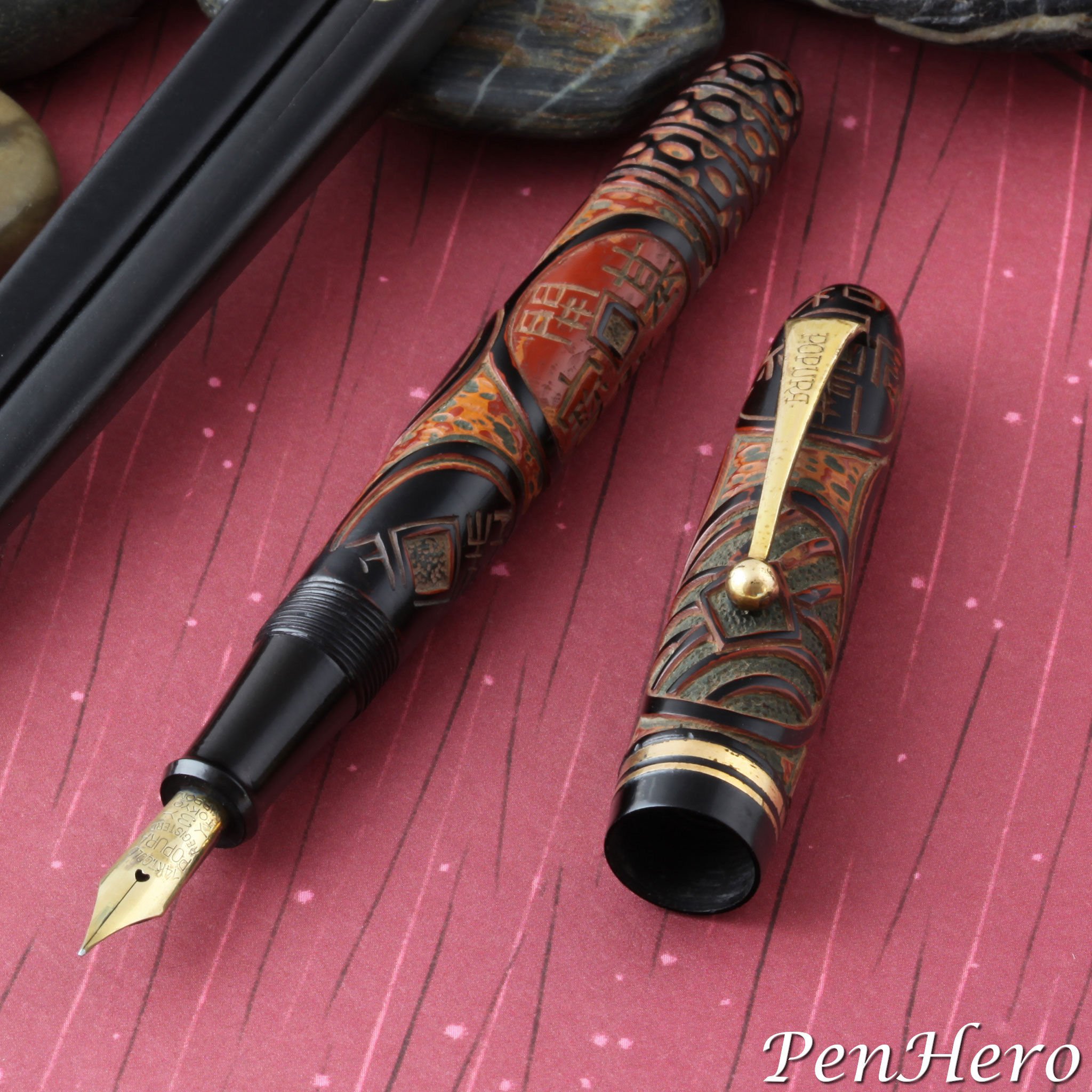 Popura ink shut off eyedropper pen in Chôshitsu style c. 1930-1937
Popura ink shut off eyedropper pen in Chôshitsu style c. 1930-1937
But wait, there's more!
Popura is a less known, possibly obscure Japanese pen company that put a lot of effort into labeling their products with the brand name on clips, nibs and barrels. Since I first wrote this article in 2017 about this single Popura pen, more information has come available that fills in some of the missing parts of the story about the brand. In this case a patent number on a barrel imprint, an address on an instruction sheet, and a pen box led to more discoveries.
This Popura ink shut off eyedropper fountain pen dates from about 1930 to 1937 because of the balance design and that it has a 14 karat gold nib without JIS markings. Unlike many pens from early small Japanese manufacturers that used rather generic hardware and trim pieces, this pen has branded metal parts. The gold plated clip is stamped with the brand name POPURA in a distinctive font with a reverse serif U. The nib is also stamped with the Popura brand along with full details: 14KT. GOLD over POPURA over REGISTERED over 3 over TOKYO over NIPPON. It’s not known if the company made their own nibs or, more likely, bought them with custom stamping.
I’ve since seen a couple more Popura branded Chôshitsu style carved pens with the branded stamped clip and gold nib. This tells me the company had on staff, or access to an artist who could produce Chôshitsu artwork. Each pen had different artwork and each design may be unique. My curiosity was further raised after seeing several undecorated urushi coated balance shaped Popura ink shut off eyedropper pens from the 1930s with clear imprints. They also had Popura branded clips and gold nibs. The imprint on those 1930s Popura pens reads:
“POPURA”U.S.A. TYPE (logo) PAT. 112212POPURA PEN MFG. CO.
The balance shape of these Popura pens and their non JIS marked nibs gives a date range from 1930 to 1937, when gold nibs were restricted from being produced due to the war effort.
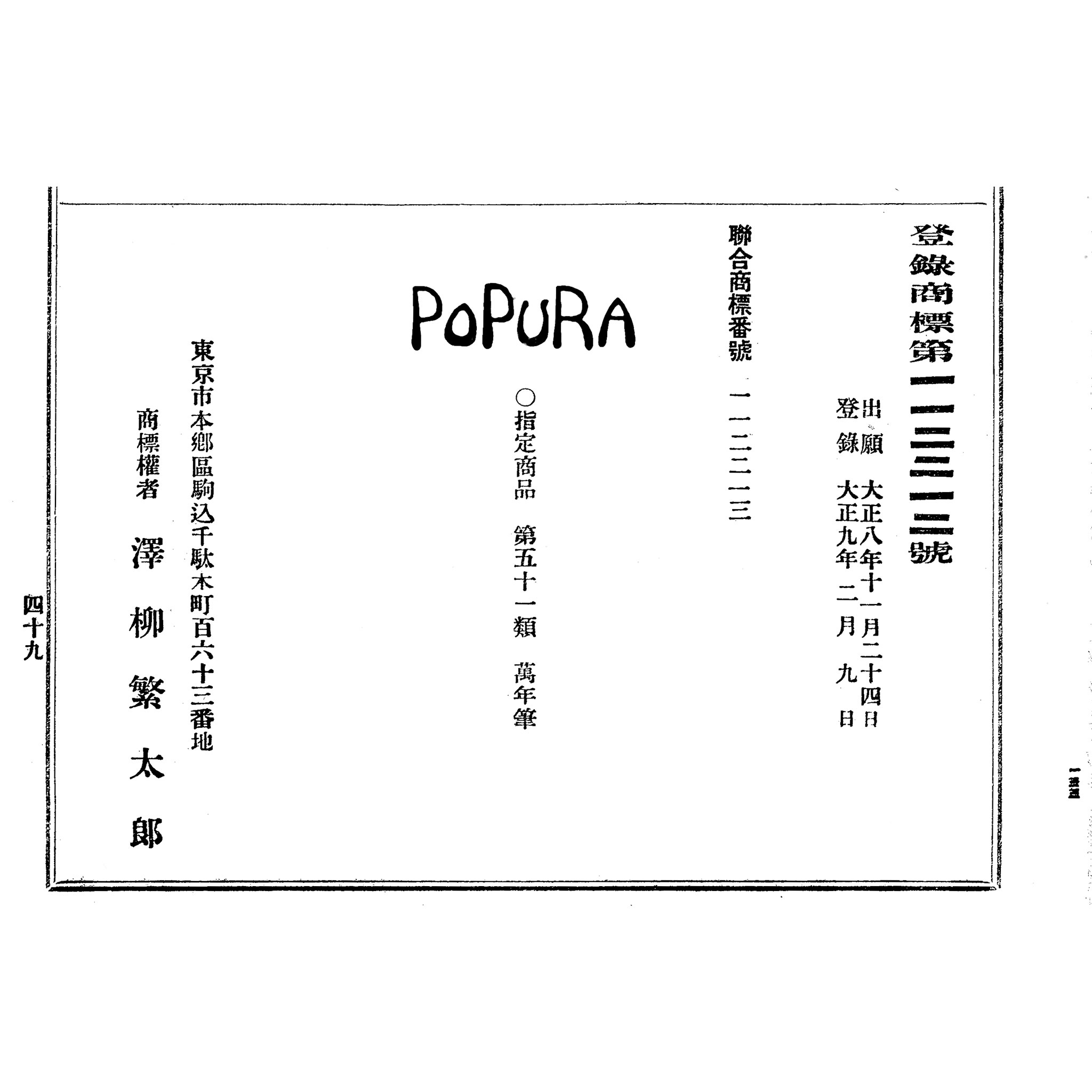 Japan Trademark Patent 112212, awarded to Shigetaro Sawayanagi on November 24, 1920
Japan Trademark Patent 112212, awarded to Shigetaro Sawayanagi on November 24, 1920
While researching the Japan Platform for Patent Information (J-PlatPat) specifically for patent number 112212, I discovered it was a trademark grant for the name and font design of Popura, specifically for use associated with fountain pens. The trademark was applied for on February 9, 1919 and awarded November 24, 1920. The trademark owner is listed as Shigetaro Sawayanagi of 163 Sendagicho, Komagome, Hongo Ward, Tokyo City. I’ve been unable to find anything about Mr. Sawayanagi, nor is the address given in the trademark award still in existence. This leads me to believe that Popura branded pens were being made at that time, over ten years earlier than thought.
My guess is that Shigetaro Sawayanagi was serious enough about making pens that he applied and received a trademark for his brand, Popura. He evidently cared a lot about the brand as existing examples of Popura pens show that the company used Popura branded parts, including the name Popura done in a unique font style stamped on the clip, Popura branded gold nibs, and clear company imprints on the barrel. It should be noted that the font used on the clips of 1930s Pupora pens is different than the one in the 1920 patent. My guess is the company felt the patent stamped on the barrel was sufficent to ward off others using the name. The company lasted at least into the 1960s, at the end making copies of Pilot pens in many colors with squeeze fillers inside. It’s from one of those later pens that I found another interesting discovery.
A boxed Popura fountain pen similar to Pilot metal cap and plastic barrel types from the late 1950s had an instruction sheet in Japanese. This was helpful in determining the company name, brand name and address, at least at that time.
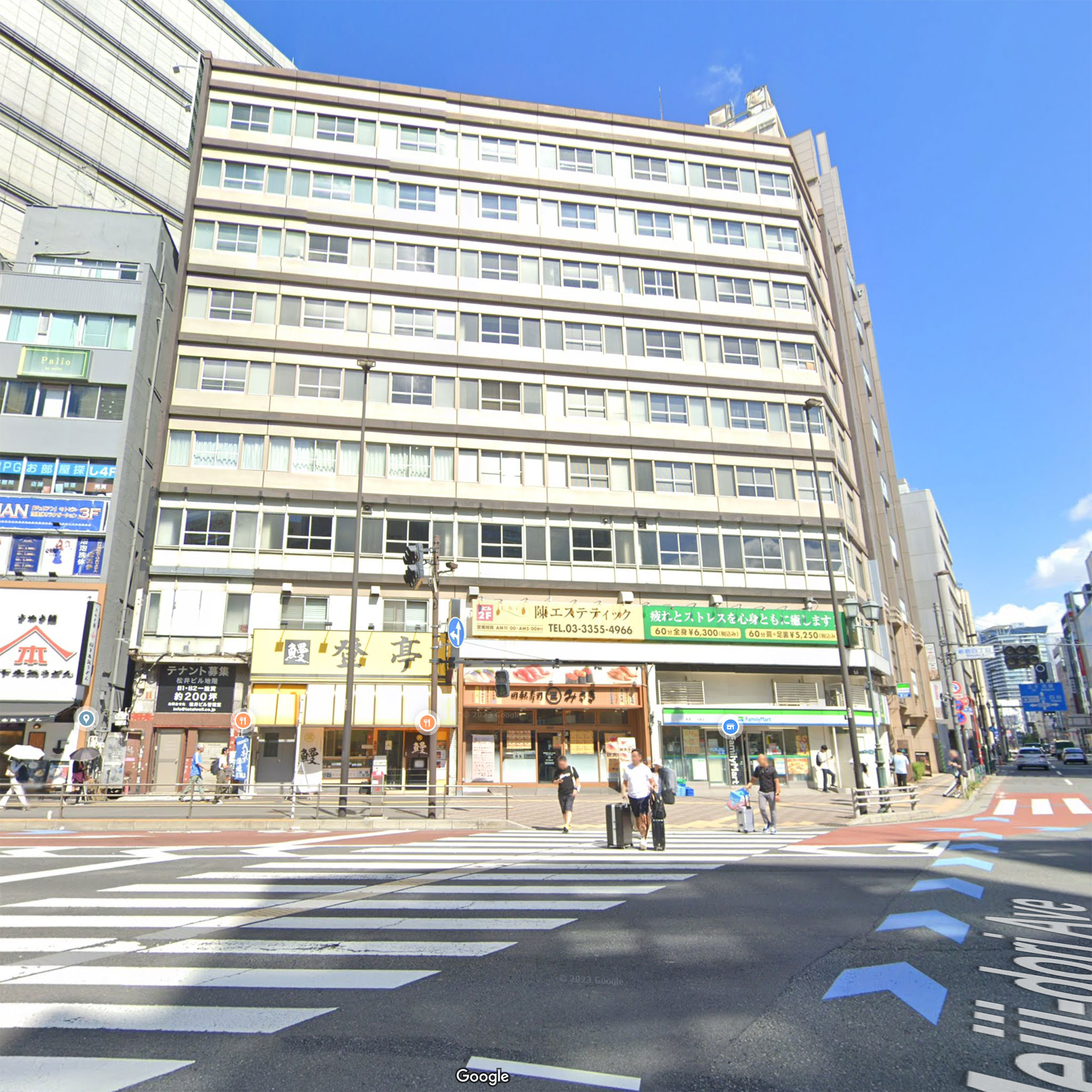 Matsui Building in Shinjuku-ku, Tokyo, Google Street View
Matsui Building in Shinjuku-ku, Tokyo, Google Street View
The instruction sheet has POPURA FOUNTAIN PEN in English at the top, but also in Japanese: ポプラ萬年筆 (Popura Fountain Pen). The company name and address also appears: ポプラ産業株式会社 (Popura Industry Company, Ltd.) with the address 3-41 Shinjuku, Shinjuku-ku, Tokyo (Matsui Building). Unfortunately, this also is an address that either no longer exists or the present day Matsui Building, now a hotel with street level retail, is a renovation of the original building. This at least indicates that the company was probably always in Tokyo and likely moved at some point from Komagome, Toshima City to Shinjuku City.
The name of the company is written using katakana, one of the two sets of syllabic Japanese script, which is used for new words that do not already exist in Japanese. Japanese words are written in kanji, which uses characters adapted from Chinese characters, or with hiragana, a syllabic script which is for Japanese words that otherwise cannot be written with kanji. Hiragana is a combination of the words hira, “ordinary,” and kana, “syllabary.” Words written with katakana typically include scientific names and terms, and words from other languages, which are usually phonetically rendered. A typical example of this would be the Japanese word for television: テレビ = phonetically te re bi (terebi). Katakana is a combination of the words kata (“fragmentary”) and kana (“syllabary”).
Because the brand name Popura is spelled out in katakana, ポスラ, it leads me to believe that like Pilot, Sailor and Platinum, the brand name is probably meant to be an English word phonetically spelled out in katakana as well as English, as shown in the trademark award. The most likely English word I can think of is the aspirational word “popular.”
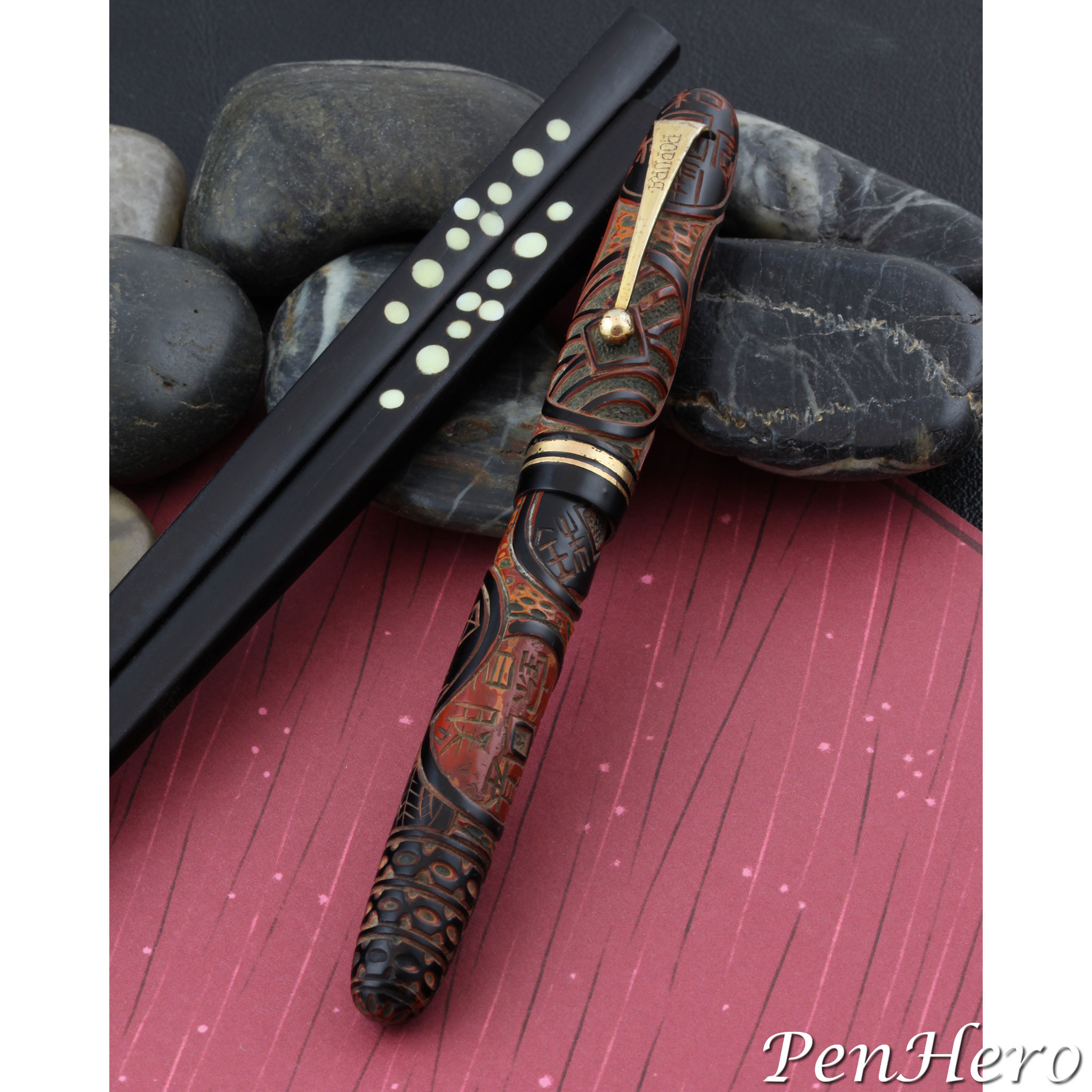 Popura ink shut off eyedropper pen in Chôshitsu style c. 1930-1937
Popura ink shut off eyedropper pen in Chôshitsu style c. 1930-1937
Heian Era Coins
The cap and barrel carving represents Heian era coins. The Heian period was from 794 to 1185 and named after the ancient capital of Kyoto. Buddhism, Taoism and other Chinese influences flourished in Japan during this time. The first coins produced in Japan by the government were made in the Wadô, literally “copper,” era (708-715), named after the discovery of copper in the Musashi. Coins from the Wadô and Heian period had square holes so they could be bundled using a cord through a group of coins, knotted at each end. Coins may only have been used by the upper classes as peasants traded by bartering goods or services.
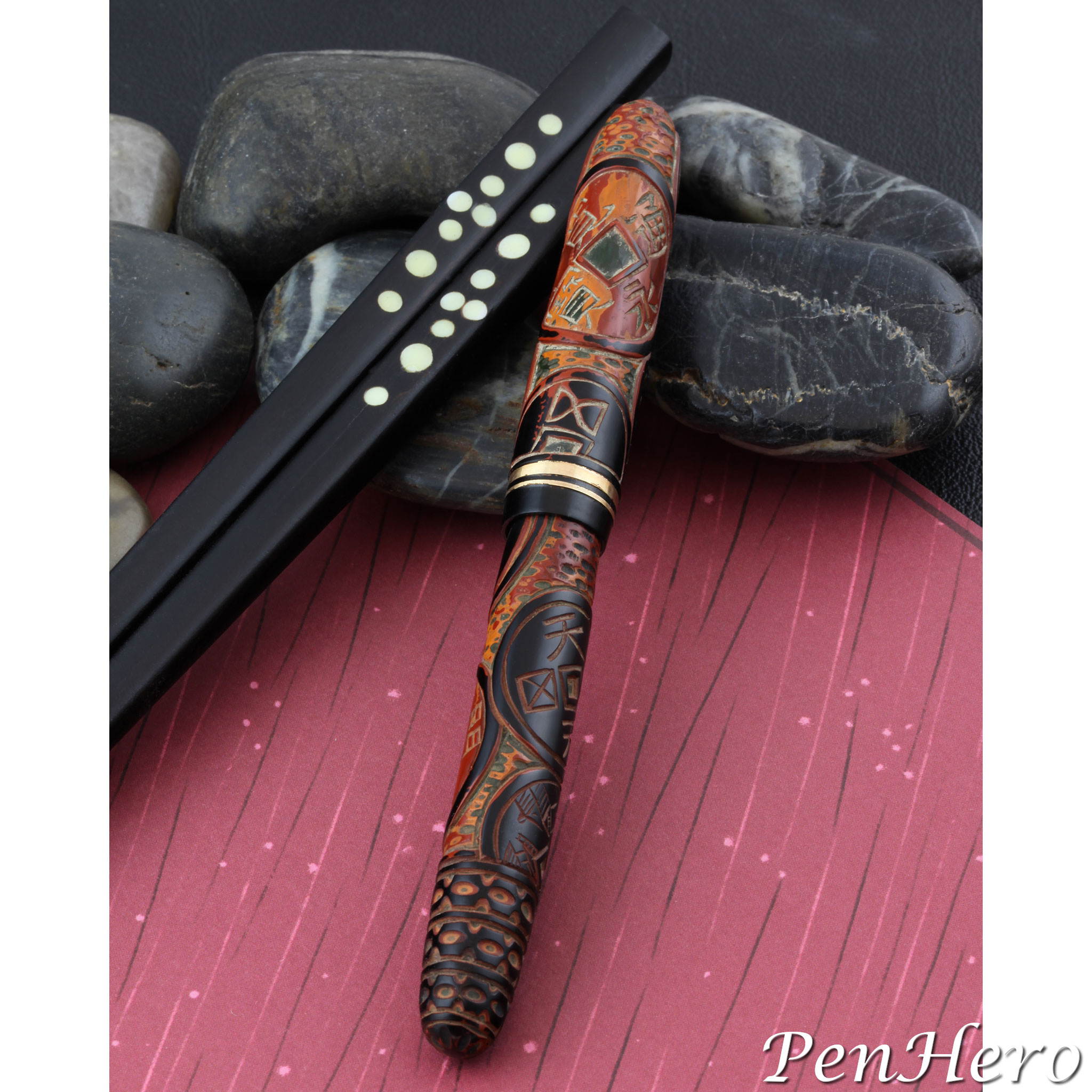 Popura ink shut off eyedropper pen in Chôshitsu style c. 1930-1937
Popura ink shut off eyedropper pen in Chôshitsu style c. 1930-1937
Chôshitsu
The artwork was done using the Chôshitsu technique. Chôshitsu artwork is a technique in which many layers of urushi lacquer are layered onto the base pen, sometimes in several colors, and then carved to achieve the desired relief design. The pen has a very heavy coating of urushi in at least three colors, dark brown, red and tan, and the dark brown layers have several shades. The very thick urushi layers allow for the deep cuts needed for the high relief carved artwork and expose the colors of each layer. According to Martin Pauli, Chôshitsu "sometimes requires several dozen up to more than a hundred layers of lacquer, sometimes requiring years to create. Occasionally the term is used to refer any form of carved lacquer. Chôshitsu is divided by color into tsuishû = red carved lacquer, tsuikoku = black carved lacquer, tsuiô 堆黄 yellow carved lacquer." Kamakura-bori is a technique where wood is carved and then lacquered to give the look of Chôshitsu.
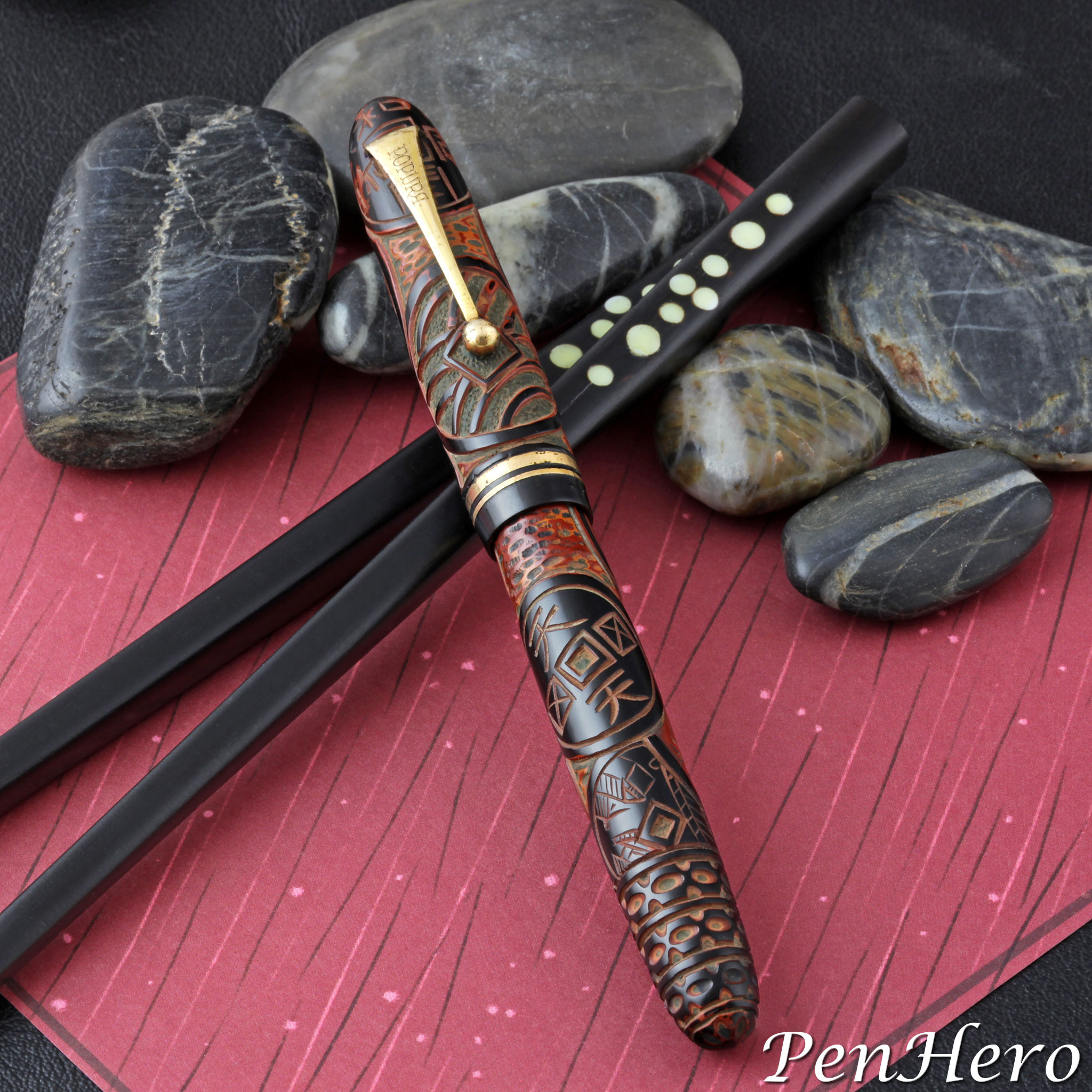 Popura ink shut off eyedropper pen in Chôshitsu style c. 1930-1937
Popura ink shut off eyedropper pen in Chôshitsu style c. 1930-1937
Identification Guide and Features:
This is an eyedropper pen with a shut-off valve at the end of the barrel. These pens fill by unscrewing the nib section and dripping ink into the open barrel using a long eyedropper. The knob at the end of the barrel is attached to a long rod that extends inside the barrel up to the base of the feed in the nib section. When the knob is screwed flush with the end of the barrel, the rod cuts off ink flow to the feed, making it an ink shut off valve. The knob must be unscrewed slightly to allow ink to flow to the nib so the user can write.
- Hard rubber cap and barrel coated in multiple layers of urushi lacquer that is then carved
- Gold plated clip stamped POPURA in a distinctive font
- Gold plated trim
- Threaded cap
- Gold nib stamped 14KT. GOLD over POPURA over REGISTERED over 3 over TOKYO over NIPPON
- Nib sizes unknown
- Eyedropper filler with safety shut off
- About 5 1/4 inches long with the cap on
Performance
This is a well-made standard size fountain pen with deeply cut Chôshitsu style artwork. The design flows around the cap and barrel as if it was a collection of coins, with many overlaying others as if left on a table. The artwork reveals multiple colors of urushi lacquer that enhance the design. The design does not extend to the nib section.
The clip and cap band probably were handsome when new, but show signs of age and wear, with quite a bit of gold plate loss. The Number 3 14 karat gold nib is firm and well-proportioned to the pen. It was not tested.
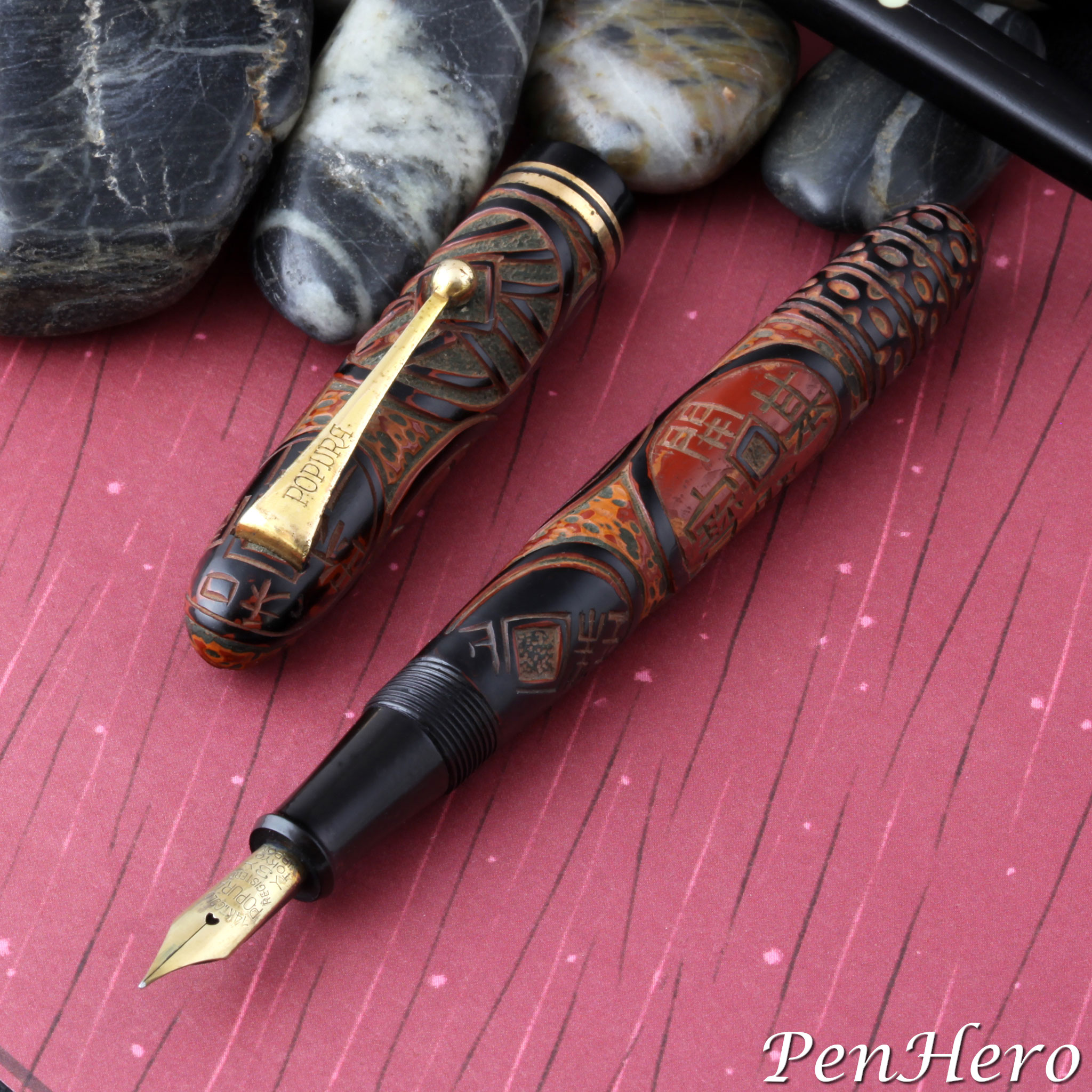 Popura ink shut off eyedropper pen in Chôshitsu style c. 1930-1937
Popura ink shut off eyedropper pen in Chôshitsu style c. 1930-1937
Pens like these are literally works of art meant to used. Maki-e has become the favored artwork for pens from Japan and there are very few modern Chôshitsu pens being made.
Because the pen was on loan, I did not ink it or write with it. To me this is pocket artwork more than just an attractive pen. The fit and finish and the carving work are excellent but showing age and use. I’ve never seen another one with this design and it’s not known if it was a one-off for a particular buyer. This would appeal to Japanese pen collectors who focus on art pens. A superb addition to any pen collection.
Acknowledgment
Thanks to Stan Klemanowicz for his help on clarifying several details in this article.
References
"Filling Systems: Overview of How They Work and How to Fill Them", by Richard Binder, © 2016 RichardsPens.com
Fountain Pens of Japan by Andreas Lambrou and Masamichi Sunami, © 2012 Andreas Lambrou Publishers, Epping, Essex, United Kingdom
"Heian Period (794–1185)", , by Department of Asian Art, The Metropolitan Museum of Art, October 2002, © 2000–2024 The Metropolitan Museum of Art
"History of Japanese Coins", © Japan MINT 1999-2024
Japan Platform for Patent Information (J-PlatPat), National Center for Industrial Property Information and Training (INPIT) search engine page
Japan Trademark Patent 112212, awarded to Shigetaro Sawayanagi on November 24, 1920
"Pen Manufacturers - Current and Past", list maintained by Stan Klemanowicz, Fountain Pen Network, February 5, 2008
Interact
Comments on this article may be sent to the author, Jim Mamoulides


